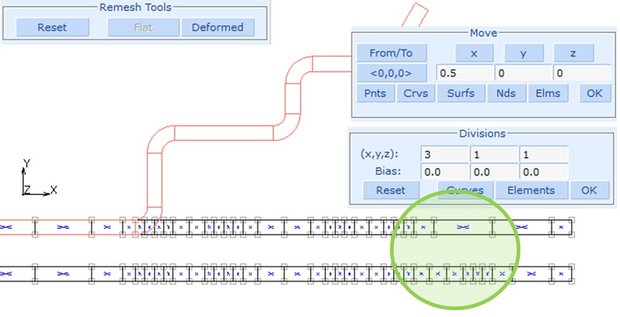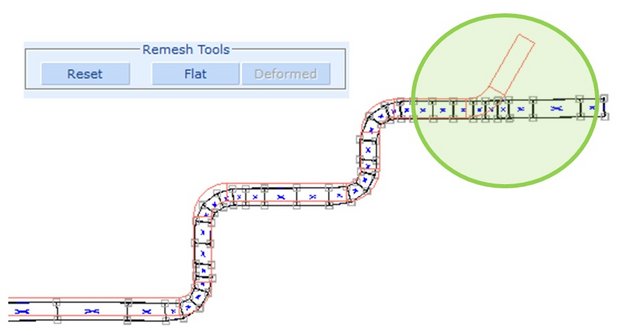
Mesh Adaptation Optimized for Roll Forming by new Advanced Restart Function
Simulation based on finite element analysis (FEA) has now long been accepted practice to predict the results of planned manufacturing processes supported by virtual models. Key success factors are obvious: substantial time and cost savings plus optimized product development and design engineering processes. Nevertheless, simulations can still turn out to be time-consuming.
To run an FEA simulation the volume of the object to be simulated is broken down into simple subdomains or what are called elements. This is called meshing. The quality of the mesh has a decisive effect on the accuracy of results. But computing effort increases with the use of a finer and tighter mesh, so the aim is to refine only where the material deforms. These are usually bending points. When you start a simulation it is generally difficult to predict the correct position of a bending point, because often there is lateral extension that shifts material and does not correspond to the bandwidth calculation on which design engineering is based. Subsequently altering the position of mesh refinement can cause the larger time investment because, to date at least, simulation had to be started again from the beginning after every mesh correction.
The new advanced restart function from data M now presents an effective solution to the problem, enabling the user to adapt the mesh specifically and avoid time-consuming repetition of the simulation process necessitated by correction.

Standard mesh adapting function not optimal for roll forming simulation
The common standard for mesh adaptation in FEA-based simulation software is socalled local adaptive refinement. This is an automatic subdivision of the mesh by predefined conditions, e.g. limit values for elongation and tension. Being a very general method, it does not allow for facts of simulation that are specific to roll forming. It is possible, for instance, that this method will not correctly identify bending points and refine them appropriately.
Where two or more bending points are deformed simultaneously you can never say for certainty from the start where the second or the next bending points can be expected. Because the appearance of lateral expansion may very much shift the location of the subsequent bending points.
A further drawback of local adaptive refinement is that the mesh is normally divided into all three axes although one or two would often be adequate. That means an exponential increase in the number of elements.
Added to which, a mesh degenerated by high degrees of reforming with this method can no longer be improved in quality. The element distortions harmful for simulation quality are transmitted to the elements created by subdivision without any new meshing.


New advanced restart function for efficient mesh adaptation
Supporting users with an efficient solution to the problems described here in the simulation of roll forming processes, data M has developed the advanced restart function for its FEA simulation software COPRA® FEA RF.
Mesh adaptation by this new functionality is user-friendly in just three steps:
- Simulation halts before the material runs into the station. Consequently, the appropriate refinements already enter the mesh before the deformations appearing in this station.
- Mesh adaptation can then be precisely positioned; any shifts of the mesh caused by lateral expansion in upstream stations are markedly recognizable at this point. This solution adapts the mesh in the flat strip; the result is then projected onto the deformed geometry. In this way the user can verify the alterations in the deformed state and compare them directly with the design cross-sections. If necessary, refinement is even possible independently in two different directions.
- Simulation then continues with the adapted mesh.
By this procedure, in a project conducted as an example at data M, it was possible to reduce the time needed for a complete simulation by all of 40%. The new COPRA FEA RF advanced restart function is of course especially useful when you only have a short time interval available between receiving an order and having to deliver.
Compared to interactive mesh adaptation using advanced restart, the number of elements for local adaptive refinement increases quite considerably, which of course is very noticeable in the overall computing time for a roll forming simulation. In one example computing time was reduced from 128 to just 5 hours by using advanced restart.
Comparison of shaped tube contour with mesh adapted to (refined at) bending points
A further benefit of the advanced restart function is the possibility of substituting a mesh degraded in quality by reforming with a new mesh of optimal quality. The outcome is positive in terms of both computing time and quality of the results.
Application of advanced restart function illustrated by shaped tube
To simulate a shaped tube, the starting material is subdivided into a uniform structured mesh. The result of this first part of simulation is a tube, the contour of which is reformed into a shaped tube in the second part of simulation. To create a mesh adapted to the geometry of the shaped tube, the uniform starting mesh is adapted.
For this purpose it is first unwound as a flat strip. Now the user can refine the mesh at the bending points of the shaped tube. In the next step the unwound and modified mesh is transformed back into the tube contour. By superimposing a cross-section of the shaped tube it is a simple matter to control and, if necessary, correct the mesh adaptation or mesh refinement.
By the advanced restart function the hole pattern can now be entered in the process at exactly the right moment. Simulation halts before the sheet metal runs into the punch station. By means of COPRA FEA RF software an adapted mesh is then generated for the hole pattern constructed in COPRA RF. This mesh is imported for advanced restart and may possibly be further processed. The old simulation results are automatically mapped onto the mesh created in this way, and simulation can continue with the newly entered hole pattern.
Clearly filed results
COPRA® FEA RF software creates a continuous file of the results. This includes individual part simulations, normally produced by restarts, with consecutive numbering. That enables simple and convenient evaluation of simulation results even throughout multiple restarts.
Power down? No problem!
The advanced restart function comes with a further benefit. After an interruption, caused by a power outage for instance, it enables you to continue a simulation where you left off. That too saves the user effort, time and expense.
Summary
The new advanced restart functionality in COPRA® FEA RF offers an entirely new process-optimized mesh adaptation at any point of simulation. The user can optimize adaptation of meshing, defining refinements and extra elements precisely where and when they make sense. Simulation is very much speeded up and improved in quality.

